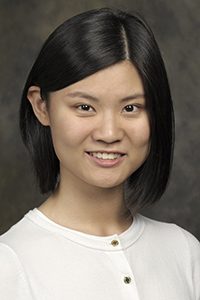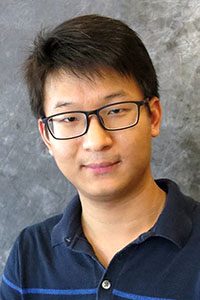The CREOL Student of the Year Award is a program to recognize the outstanding academic, scientific and professional achievements of graduate students in CREOL.

Optical thermodynamic theory of nonlinear highly multimoded systems
The complex nonlinear behaviors of heavily multimode lightwave structures have been recently the focus of considerable attention. The convoluted spatial-temporal interaction opened up a new avenue for tailoring the response of multimode arrangements. Not only opportunities, the intrinsic dense nonlinear model interaction also, nevertheless, brought new challenges to the study of such heavily multimoded systems. In this talk, I present an optical thermodynamic approach capable of describing in a universal fashion the exceedingly intricate behavior of such nonlinear highly multimoded photonic configurations. By introducing pertinent extensive variables, we derive new equations of state and show that both the “internal energy” and optical power in many-mode arrangements always flow in such a way so as to satisfy the second law of thermodynamics. The laws governing isentropic processes are derived and the prospect for realizing Carnot-like cycles is also presented. In addition to shedding light on fundamental issues, our work may pave the way towards a new generation of high power multimode optical structures and could have ramifications in other many-state nonlinear systems, ranging from Bose-Einstein condensates to optomechanics.
Fan Wu is currently a Ph.D. candidate in Dr. Demetrios Christodoulide’s Nonlinear Waves group. He received his B.S. and M.S. degrees, both in Physics, from Harbin Institute of Technology in 2012 and 2014, respectively. He has worked in the general areas of nonlinear waves in both bulk and waveguide arrangements. In particular, he has made contributions to the development of a comprehensive optical thermodynamics theory that can be used to effortlessly describe the collective nonlinear behaviors of multimode photonic systems. Additional research interests also include orbital angular momentum light sources and rogue waves.
Runners-up

High-Dynamic-Range Mini-LED backlit Liquid Crystal Displays
Mini-LED backlit liquid crystal display (LCD) is emerging as a competitive candidate for high dynamic range displays for the merits of high luminance, excellent dark state, high reliability, long lifetime and reasonable cost. The biggest challenge in mini-LED backlit LCD designs is to accurately reproduce display contents without increasing hardware burdens. In this work, we built a model to simulate the optical performance of mini-LED backlit LCD systems. Through simulations and subjective experiments, we found how the hardware arrangement influence the display performance, and answered at which level the annoying halo effect and motion blur can be suppressed to an unnoticeable level. Our work provides guidelines for designing high dynamic range mini-LED backlit LCDs.
Yuge “Esther” Huang is currently a Ph.D. candidate in Dr. Shin-Tson Wu’s Liquid Crystal Photonics and Display Group. She received the B.S. degree in physics from Nanjing University in 2015. Her research interests include mini/micro-LED displays, liquid crystal photonics, and spatial light modulators. She received SID Distinguished Student Paper Award in 2016, SID Academic Award in 2018, and IEEE Orlando Section Outstanding Graduate Student Scholarship Award in 2019. Her work has been highlighted on OSA News Release and AIP News Release.

Fluorescence microscopy with tailored illumination light
Fluorescence microscopy has long been a valuable tool for biological and medical imaging, which plays important roles in the understanding and development of disease treatment and drug discovery. While numerous fluorescence imaging techniques have been developed over the past decades, there is an inevitable tradeoff among the spatial and temporal resolution, image contrast, photodamage and the total cost when it comes to choose the appropriate microscope. A main goal of my PhD studies is to develop state-of-the-art microscopic imaging systems that are suitable for 3D single-molecule fluorescence imaging and live-cell imaging for biomedical applications. In this talk, I will mainly focus on the imaging system innovation and beam tailoring techniques that I have developed to improve the sectioning capability in wide-field fluorescence microscopy and light sheet microscopy.
Jialei Tang is currently a PhD student in Dr. Kyu Young Han’s research group. He received his B.S. degree from University of Science and Technology of China (USTC) in 2012, and his M.S. degree from Chinese Academy of Sciences, Shanghai Institute of Optics and Fine Mechanics (CAS, SIOM) in 2015. His research focuses on the development of microscopic imaging system for 3D non-invasive single molecule fluorescence imaging and super-resolution imaging in cells and tissues. He has authored and coauthored 8 journal papers and 2 patents during his PhD studies.